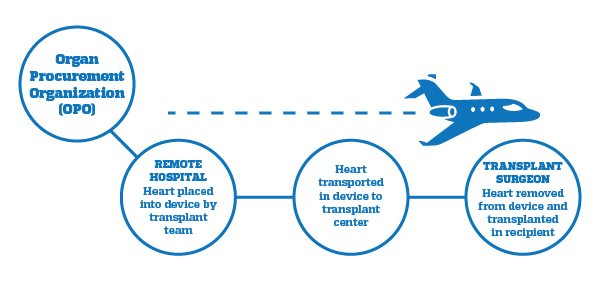Heart Transplantation Process
In the United States, the procedure for a heart transplant is as follows:
Donors are individuals who are brain dead, meaning that brain studies demonstrate no neurological function. The donor is maintained by mechanical ventilation in an intensive care unit.
While these donors are maintained, their information is listed in the United Network for Organ Sharing (UNOS) database.
After family consent is obtained, a potential recipient is identified.
The donor’s heart is completely removed under the supervision of heart surgeons and an organ procurement organization (OPO). An OPO is a nonprofit agency that coordinates the recovery, preservation and transportation of organs donated for transplantation.
Under the current protocol, the heart is placed into a saline filled container and then into an insulated cooler packed with ice.
It is then quickly flown to the recipient, who is at the transplant center. This practice, known as hypothermic storage, keeps hearts viable for 3 to 4 hours.

Current limitations
This 3- to 4-hour time window does not allow for conventional tissue matching, a practice done with other organ transplants (such as kidney and pancreas) that determines if the organ tissue will be compatible with the recipient’s tissue.
Should the donor and recipient be incompatible, the recipient’s body will likely reject the donor organ, requiring extra immunosuppressive medications. The outcome of rejection is not good. In fact, 20 percent of heart transplants mortality is directly from rejection of the donor heart by the recipient’s immune system.
The 3- to 4-hour timeframe also limits the number of candidates available to receive the heart, as the recipient needs to be in close enough proximity transplant center for the transplant to occur before the heart becomes undesirable; surgeons call this a “marginal heart.” A marginal heart can quickly become unusable for transplantation due to the stresses of cold storage in an insulated container – typically a cooler.
Asporto improves heart transplants
Hibernicor’s Asporto heart preservation device improves and prolongs preservation of the donor heart. In its current prototype, Asporto can preserve a donor heart up to 6 hours.
Read more about how Asporto works.
